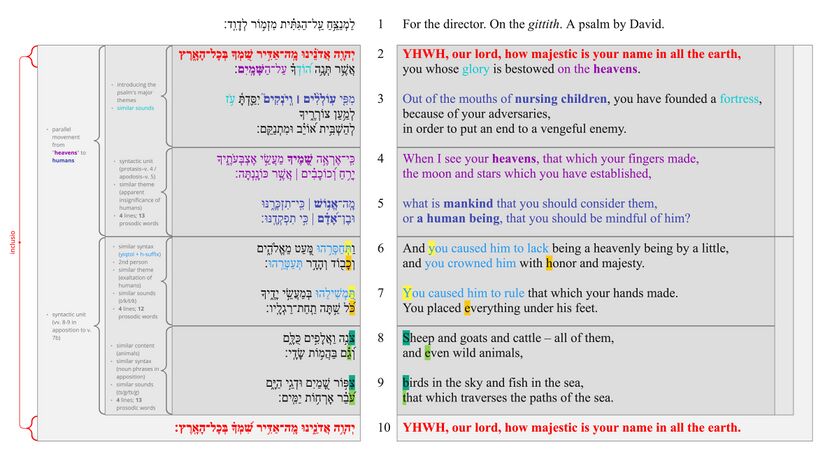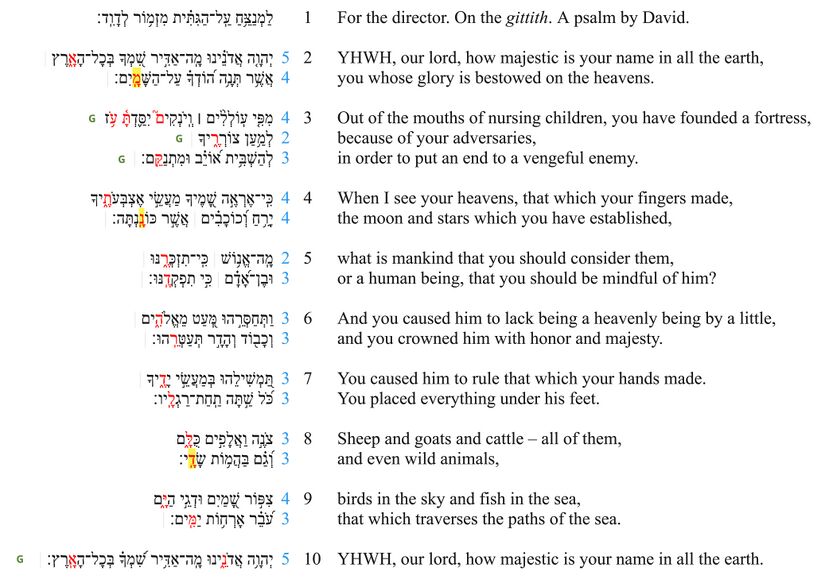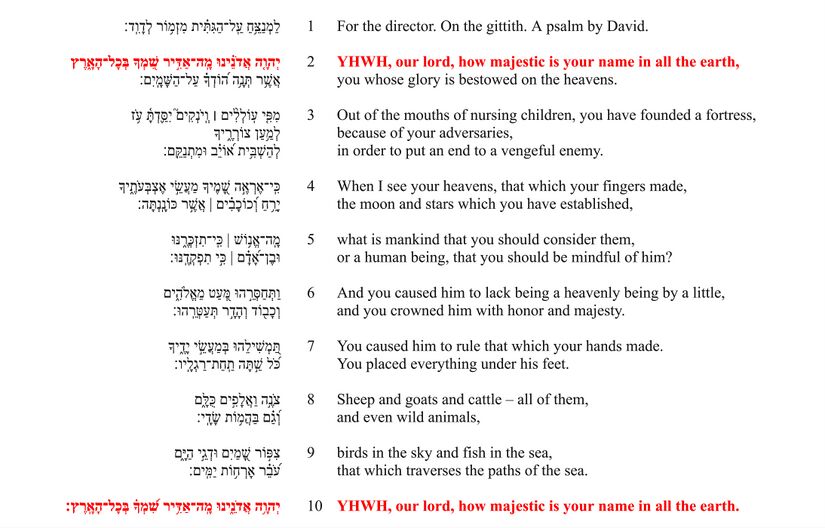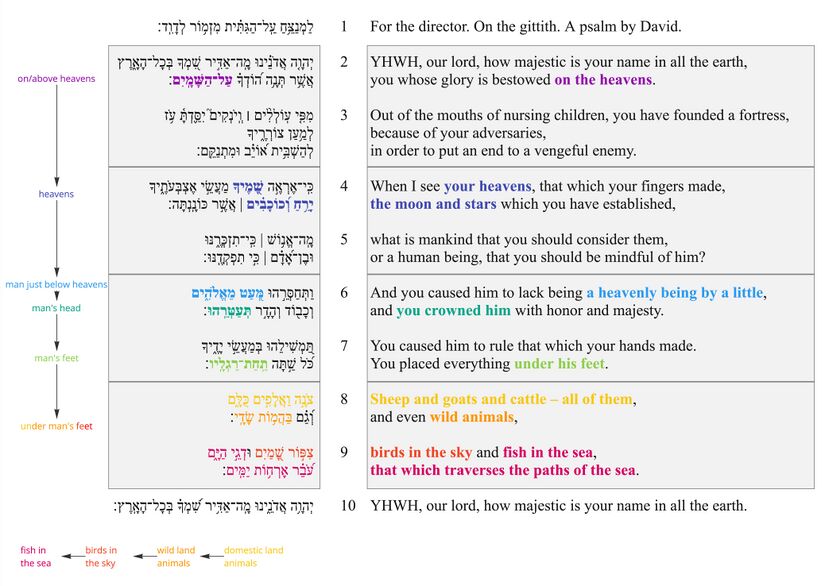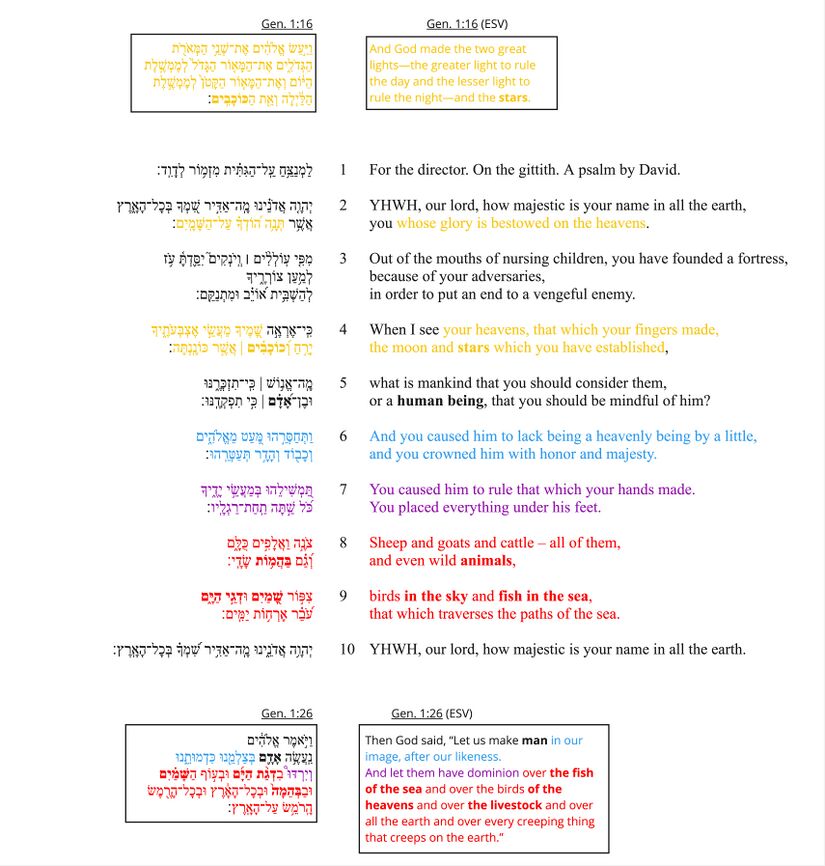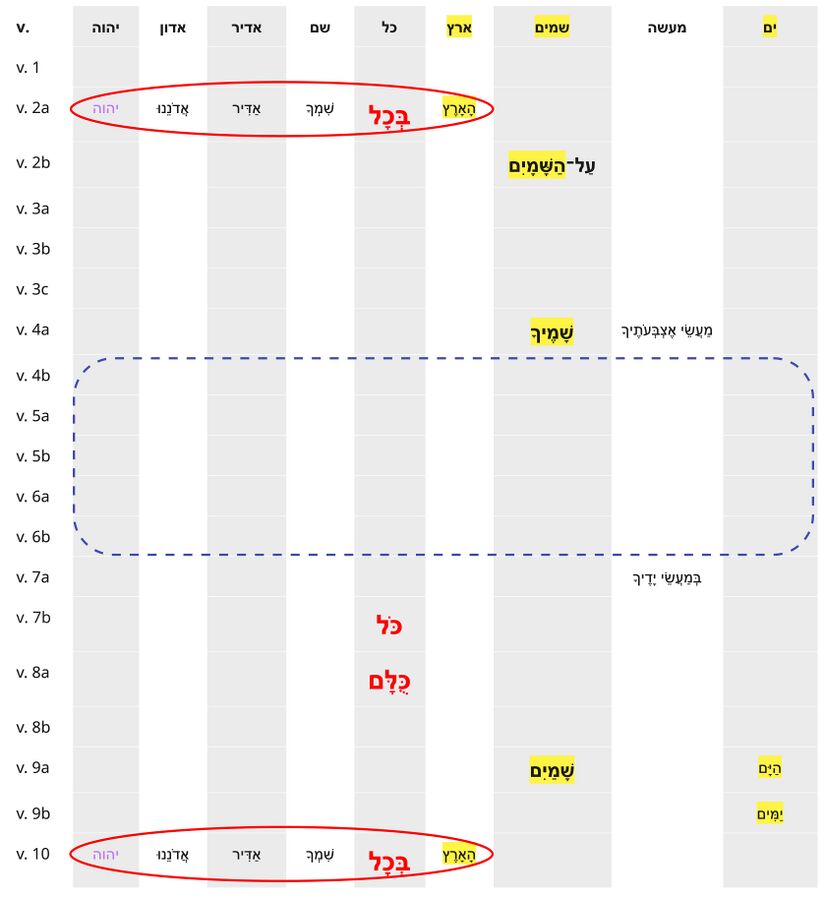Psalm 8 Poetics
About the Poetics Layer
Exploring the Psalms as poetry is crucial for understanding and experiencing the psalms and thus for faithfully translating them into another language. This layer is comprised of two main parts: poetic structure and poetic features. (For more information, click 'Expand' to the right.)
Poetic Structure
In poetic structure, we analyse the structure of the psalm beginning at the most basic level of the structure: the line (also known as the “colon” or “hemistich”). Then, based on the perception of patterned similarities (and on the assumption that the whole psalm is structured hierarchically), we argue for the grouping of lines into verses, verses into sub-sections, sub-sections into larger sections, etc. Because patterned similarities might be of various kinds (syntactic, semantic, pragmatic, sonic) the analysis of poetic structure draws on all of the previous layers (especially the Discourse layer).
Poetic Features
In poetic features, we identify and describe the “Top 3 Poetic Features” for each Psalm. Poetic features might include intricate patterns (e.g., chiasms), long range correspondences across the psalm, evocative uses of imagery, sound-plays, allusions to other parts of the Bible, and various other features or combinations of features. For each poetic feature, we describe both the formal aspects of the feature and the poetic effect of the feature. We assume that there is no one-to-one correspondence between a feature’s formal aspects and its effect, and that similar forms might have very different effects depending on their contexts. The effect of a poetic feature is best determined (subjectively) by a thoughtful examination of the feature against the background of the psalm’s overall message and purpose.
Poetics Visuals for Psalm 8
Poetic Structure
Poetic Macro-structure
- vv. 2a, 10. The psalm is bound by an inclusio (cf. the inclusio in Ps 103).
- vv. 2b-3. Verse 2b is connected both to the previous line and to the following lines. As Waltke writes, "Verse 2b is a janus. It is linked to the superscript 2a by an exceptional relative 'who,' by the Masoretic accents that retain the earliest known interpretation of the psalm, and by this parallelism: (A) I AM (B) how majestic is your name (C) in all the earth // (A') You who (B') place your splendor (C') upon the heavens."[1] There are also sound correspondences that join v. 2b and v. 2a (shamayim // shimka; tenah // mah; adir // hod). At the same time, v. 2b is connected to the body of the psalm, introducing the theme of glory on the heavens (cf. v. 4f) and the point of departure for the vertical descent that runs throughout the rest of the psalm ("on/above the heavens", see poetic feature #2).
- vv. 4-5. Verses 4-5 are bound together as a single syntactic unit; v. 4 is the protasis ("when..."), and v. 5 is the apodosis ("then..."). These two verses share a similar theme: the apparent insignificance of humanity (v. 5) compared with the heavens (v. 4). This section is parallel to the previous section; both move from the heavens above (v. 2b // v. 4) to weak humanity below (v. 3 // v. 5).
- vv. 6-7. Verses 6-7 are bound together by similar syntax (the use of 2ms yiqtol verbs with he suffixes), a similar theme (the exaltation of humans), and the alternating sequence of lines that begin with tav and kaf. Some see a chiasm in the verb forms.
- vv. 8-9. Verses 8-9 are bound together by similar syntax (appositional noun phrases), similar content (animals), and an alternating sequence of lines that begin with ts and g.[2]
The first half of Psalm 8 ends with a rhetorical question (v. 5) which is then answered in the second half of the psalm (vv. 6-9). Cf. Ps 11.
Line Division
Notes
- vv. 2-3. The line division of vv. 2-3 is difficult. In the visual above, v. 2b is taken as a verse together with v. 2a, and the phrase מִפִּ֤י עֽוֹלְלִ֨ים ׀ וְֽיֹנְקִים֮ is grouped with what follows rather than what precedes. This division follows the traditional interpretation of the Masoretic accents which is supported also by the ancient versions (LXX [cf. Matt. 21:16], Jerome, Peshitta, Targum). See [1].
- v. 3. No division is made at the sinnor in v. 3, since this would leave יִסַּ֪דְתָּ֫ עֹ֥ז on its own line, and lines do not usually have one prosodic word.[3]
Top Poetic Features
1. How Majestic
Feature
The last line of the psalm (v. 10) repeats the first line (v. 2a) verbatim: יְהוָה אֲדֹנֵינוּ מָה־אַדִּיר שִׁמְךָ בְּכָל־הָאָרֶץ
Effect
"A perfect circle is closed: the majesty of God, affirmed at the beginning, restated verbatim at the end, but with the sense accrued through the intervening eight lines of what concretely it means for His name to be majestic throughout the earth."[4] The "sense accrued" throughout the psalm is surprising. The opening declaration of Yahweh's majesty (v.2ab) is expounded, perhaps unexpectedly, with images of helpless children (v.3) and frail humans (v.5). When the same words are repeated in v.10, the meaning has developed in a surprising way: Yahweh's royal majesty is manifested in weakness.
2. From Top to Bottom
Feature
"Throughout the first six verses of the poem, the poet has subtly woven in a motif of vertical descent: v.2c above heavens → v.4a heavens... moon and stars → v.6a but a little lower than heavenly beings → v.6b crowned them (a reference to the head) → v.7a hands → v.7b feet. Having descended to earth, the psalmist now changes directions and describes a horizontal vector that moves outward from human society: sheep and oxen → beasts of the field → birds → fish → whatever passes the paths of the seas."[5]
Effect
YHWH's majesty is evident in the greatest heights of the heavens (v. 2b) as well as in the lowest depths of the ocean (v. 9b). The whole world displays the majesty of its creator and king (vv. 2a, 10).
At the centre of creation (and the centre of the psalm) are humans who stand between heaven and earth as the "image of God" (Gen 1:26f) and the mediators of God's rule.
3. In the Beginning
Feature
Ps 8:8-9 lists three basic categories of animals: (1) land animals, domestic and wild (v. 8), (2) birds (v. 9aα), (3) fish (v. 9aβb). This taxonomy closely resembles the list of animals in Gen 1:26-28, though the two passages use slightly different terminology (עוף vs צפור for "birds" and בהמות שדי vs חיה for "wild animals"): (1) land animals, domestic and wild (2) birds, (3) fish.
In addition to the listing of animals, the description of man's dominion in Ps 8:6-7 also recalls Genesis 1:26-28 and the creation of man as God's image "to rule" the animals. Likewise, the description of "glory on the heavens" (v. 2b) may recall the dominion which YHWH gave to the heavenly bodies (Gen 1:16-18).
Effect
The parallels between Gen 1:26-28 and Ps 8 lead Waltke to conclude that "Psalm 8 is Genesis 1:26-28 set to music."[6] Similarly, Gentry says that Ps 8:6-9 is "a word-by-word commentary and meditation on Genesis 1:26-28."[7] The different terms used for wild animals and birds in Ps 8 – words which are normally used for domestic creatures – may have been chosen in order to affirm the fact that these creatures are subject to humans.[8]
Repeated Roots
(For more information, click "Repeated Roots Legend" below.)
| Repeated Roots legend | |
|---|---|
| Divine name | The divine name is indicated by bold purple text. |
| כֹּל | The repetition of כֹּל, which emphasizes the universality of divine/human dominion, is indicated by bold red text. |
| Spheres of divine/human dominion | Repeated words referring to the spheres of divine/human dominion are highlighted in yellow. |
| Roots forming an inclusio are indicated by a red circle. | |
| The absence of repeated roots in the middle of the psalm is indicated by a dotted box. | |
- Identical beginning (v. 2) and ending (v. 10) = inclusion
- No repeated roots in middle of the Psalm (vv. 4b-6)
- The words/roots repeated most often are שמים (x3) and כל (x4).
- Repetition of כֹּל (x4) emphasizes the universality of divine/human dominion. It is used twice in the frame of the psalm to refer to the scope of God's dominion (vv.2b, 10b) and twice in the body of the psalm to refer to the scope of humanity's dominion (vv.7b-8a). Alter identifies כֹּל as "the chief thematic key-word of the psalm. [God's] dominion is over all, heaven and earth, angels and men and creatures of the field and air and sea, and he places 'all' at the feet of man."[9]
- About half of the repeated words refer to the spheres of divine/human dominion (land [ארץ] x2, sky [שׁמים] x3, sea [יָם] x2). Again, as with כֹּל (see above), the emphasis is on the universality of human/divine dominion. According to Genesis 1, God created the sky (שׁמים) on Day 2, and the land (ארץ) and seas (ימים) on Day 3. These three realms together make up the cosmos. When God creates humans on Day 6, he gives them dominion over the creatures in each of these three realms (Gen 1:26).
Bibliography
- Alter, Robert. 1985. The Art of Biblical Poetry. New York: Basic Books.
- Gentry, Peter J., and Stephen J. Wellum. 2012. Kingdom Through Covenant: A Biblical-Theological Understanding of the Covenants. Wheaton: Crossway.
- Jacobson, R. A. 2014. "Psalm 8," in N. DeClaissé-Walford, R. A. Jacobson & B. L. Tanner (eds.) The Book of Psalms. Grand Rapids, MI: Eerdmans.
- Krohn, Rachel. 2021. “A Syntactic Description of Biblical Hebrew Poetry: The Revised and Extended Hebrew Verse Structure Model.” Doctoral thesis.
- Waltke, Bruce K., J. M. Houston, and Erika Moore. 2010. The Psalms as Christian Worship: A Historical Commentary. Grand Rapids, Mich: William B. Eerdmans Pub. Co.
- Whitekettle, Richard. 2006. “Taming the Shrew, Shrike, and Shrimp: The Form and Function of Zoological Classification in Psalm 8.” JBL 125: pp. 749-65.
